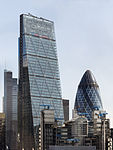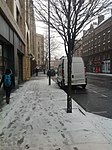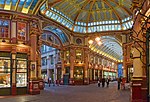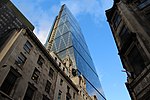Lloyd's building

The Lloyd's building (sometimes known as the Inside-Out Building) is the home of the insurance institution Lloyd's of London. It is located on the former site of East India House in Lime Street, in London's main financial district, the City of London. The building is a leading example of radical Bowellism architecture in which the services for the building, such as ducts and elevators, are located on the exterior to maximise space in the interior. In 2011, twenty-five years after its completion in 1986 the building received Grade I listing; at this time it was the youngest structure ever to obtain this status. It is said by Historic England to be "universally recognised as one of the key buildings of the modern epoch". However, its innovation of having key service pipes, etc routed outside the walls has led to very expensive maintenance costs due to their exposure to the elements.
Excerpt from the Wikipedia article Lloyd's building (License: CC BY-SA 3.0, Authors, Images).Lloyd's building
Lime Street, City of London
Geographical coordinates (GPS) Address External links Nearby Places Show on map
Geographical coordinates (GPS)
| Latitude | Longitude |
|---|---|
| N 51.513055555556 ° | E -0.082361111111111 ° |
Address
Lloyd's of London
Lime Street 1
EC3M 7HA City of London
England, United Kingdom
Open on Google Maps










